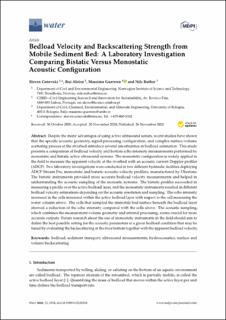| dc.description.abstract | Despite the many advantages of using active ultrasound sonars, recent studies have shown that the specific acoustic geometry, signal-processing configuration, and complex surface-volume scattering process at the riverbed introduce several uncertainties in bedload estimation. This study presents a comparison of bedload velocity and bottom echo intensity measurements performed by monostatic and bistatic active ultrasound systems. The monostatic configuration is widely applied in the field to measure the apparent velocity at the riverbed with an acoustic current Doppler profiler (ADCP). Two laboratory investigations were conducted in two different hydraulic facilities deploying ADCP Stream Pro, monostatic and bistatic acoustic velocity profilers, manufactured by Ubertone. The bistatic instruments provided more accurate bedload velocity measurements and helped in understanding the acoustic sampling of the monastic systems. The bistatic profiles succeeded in measuring a profile over the active bedload layer, and the monostatic instruments resulted in different bedload velocity estimations depending on the acoustic resolution and sampling. The echo intensity increased in the cells measured within the active bedload layer with respect to the cell measuring the water column above. The cells that sampled the immobile bed surface beneath the bedload layer showed a reduction of the echo intensity compared with the cells above. The acoustic sampling, which combines the measurement volume geometry and internal processing, seems crucial for more accurate outputs. Future research about the use of monostatic instruments in the field should aim to define the best possible setting for the acoustic parameters at a given bedload condition that may be tuned by evaluating the backscattering at the river bottom together with the apparent bedload velocity. | en_US |

